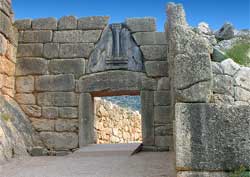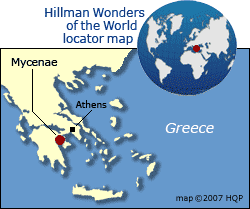Mycenae
 Why
Mycenae in Greece
is special
Why
Mycenae in Greece
is specialThe ancient city of Mycenae in southern Greece is enveloped in a fascinating combination of myth and historical facts.
Mycenae tips and insights
Homer
His famous 2900-year-old epic the Iliad spins the story of the Trojan War. One key character was Agamemnon, King of Mycenae on the Peloponnesus Peninsula of Greece.
Classical Greek mythology
It tells us of a tragic King Agamemnon tale that takes place mainly in Mycenae. It goes like this:
- Thyestes (Agamemnon's uncle) seduces Agamemnon's mother.
- To get even, Atreus (Agamemnon's father) tricks Thyestes into eating his own children.
- Thyestes retaliates by cursing Atreus and his family.
- Years later, Helen (the wife of Agamemnon's brother Menelaus) is abducted to Troy, triggering the Trojan War.
- When Agamemnon returns to Mycenae from that long confrontation, he is murdered by his unfaithful wife Clytemnestra.
- Her son Orestes takes revenge of his father's slaying by killing her.
- That deed of taking the life of his own mother persuades the mythical furies to try to assassinate Orestes.
Heinrich Schliemann
Until 1874, most historians thought that Agamemnon and his Mycenae never existed. That was the year when the excavations by Heinrich Schliemann proved that both were real. He is the same amateur archaeologist whose earlier excavations showed that Troy was not a myth.
History in brief
Mycenae was a major military power and maritime trader from about 20th to 12th centuries BC. It reached its peak from around 1400 to 1200 BC. In that period, Mycenae defeated the Minoans in Crete and took control of that island in southern Greece.
Current physical condition
Basically, all that remains of the hilltop Mycenae citadel are stone walls, subterranean tombs, and the Lion Gate - but they are interesting enough to attract numerous tourists.
Lion Gate
It's the icon of Mycenae. Its massive lintel is crowned with a huge stone relief of two lions. The second best known tourist attraction is the Tomb (or Treasury) of Atreus. It has a striking bee-hive designed ceiling.
Getting there
Mycenae is a popular daytrip from Athens, Greece. It is sometimes combined with a visit to Epidaurus (another Hillman Wonder medalist).
Location in Greece



